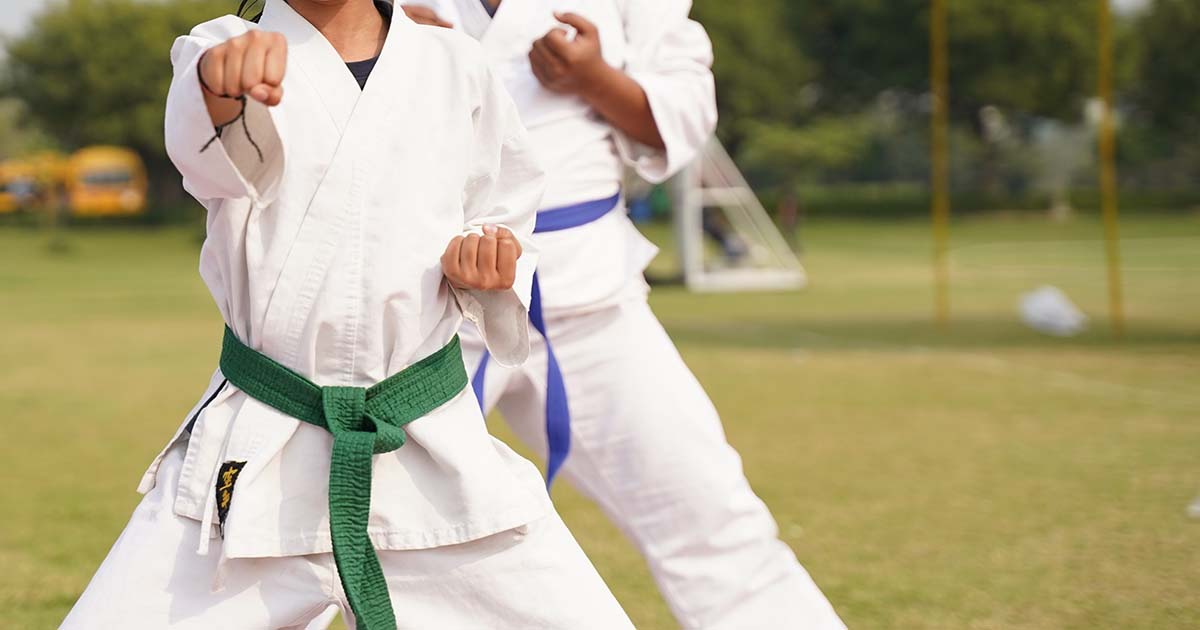When you think of karate or almost any other martial art, you probably think of belts.
Students and parents have many questions related to how belts work in karate.
In this post, I’ll do my best to answer these questions and explain the significance of belts.
What Is The Purpose Of Belts In Karate?
A belt (obi in Japanese) serves a variety of functions in martial arts.
First, belts are practical:
- They could be used to hold up a person’s pants so they don’t fall down.
- They could also hold items for self-defense, such as weapons like the sai.
Beyond their pragmatic purposes, belts can represent rank and demonstrate one’s progress throughout their martial arts journey.
For that reason, it’s considered a rite of passage to earn a new belt in karate.
Progressing from white to yellow belt, for example, means that you’ve successfully demonstrated knowledge, skills, and abilities over time and are ready to unlock new knowledge and techniques at the next level.
Someone can use the color of a belt to make an educated guess about a person’s skill level.
In fact, this is one way tournament directors can group students into divisions.
They use a student’s rank to establish fair competition so that white and yellow belts aren’t competing with black belts.
What Karate Belts Are There?
Karate belts vary by school, style, and potentially even by the organization or association to which a school belongs.
Covering every type of belt ranking system is beyond the scope of this article.
As an affiliated school with the International Okinawan Budo-Kai, Metamora Martial Arts follows its recommended promotion guidelines.
The IOBK and Metamora Martial Arts belt ranking system is as follows:
| Color | Rank | Level |
| White | 9th – kukyu | Beginner |
| White, 1 green stripe | 8th – hachikyu | Beginner |
| White, 2 green stripes | 7th – nanakyu | Beginner |
| Yellow | 6th – rokkyu | Beginner |
| Orange | 5th – gokyu | Intermediate |
| Green | 4th – yonkyu | Intermediate |
| Brown | 3rd – sankyu | Intermediate |
| Brown, 1 black stripe | 2nd – nikyu | Intermediate |
| Brown, 2 black stripes | 1st – ikkyu | Intermediate |
| Black Black, white stripe | 1st-degree black belt – Shodan 1st-degree black belt – Shodan ho (Junior – Under 16) | Advanced |
| Black, 2 stripes | 2nd-degree black belt – Nidan May be conferred title of Fuku Shidoin | Advanced |
| Black, 3 stripes | 3rd-degree black belt – Sandan May be conferred title of Shidoin | Advanced |
| Red / White / Black | 4th-degree black belt – Yondan May be conferred title of Renshi | Advanced |
| Red / White / Black | 5th-degree black belt – Godan | Advanced |
| Red / White | 6th-degree black belt – Rokudan May be conferred title of Shihan | Advanced |
| Red / White | 7th-degree black belt – Nanadan May be conferred title of Kyoshi | Advanced |
| Red / White | 8th-degree black belt – Hachidan | Advanced |
| Red | 9th-degree black belt – Kudan May be conferred title of Hanshi | Advanced |
| Red | 10th-degree black belt – Kudan | Advanced |
Students under 16 years old will be awarded with a junior black belt.
To be promoted from one rank to the next, a student must demonstrate proficiency with the requirements of each rank.
And, students must be able to perform a previous rank’s material.
For example, a green belt will still need to remember the white, yellow, and orange belt requirements.
Other schools have different ways of handling belt colors:
- They issue belt colors like blue or purple within their system.
- They may switch the order of belts (like issuing a blue belt before green belt, for instance).
- They might also include two-toned belts.
Please check with your instructor on the rank requirements for your school.
What Are Kyu vs. Dan Ranks?
Sometimes, you may hear colored belts referred to as kyu ranks and black belts referred to as dan ranks.
A kyu rank is any martial arts student who is not a black belt.
Kyu ranks are numbered in descending order—the closer you are to black belt, the closer your number gets to one.
That’s why, for example, white belts have a greater number for kyu rank than brown belts.
Dan ranks are at the black belt level and go in ascending order.
Newer black belts are 1st dan, or shodan—they have demonstrated that they are ready for the next levels of martial arts—and veteran martial artists are 9th and 10th dan.
How Long Does It Take To Get Each Belt In Karate?
The short answer is: it depends.
Many instructors will publish their rank requirements, and those often involve a “minimum time in grade” to achieve a new rank.
In other words, a school might say that a yellow belt must be a yellow belt for three months before moving to the next rank of green belt.
Please know that a minimum time in grade is not the school’s way of saying, “Okay, your student has been a yellow belt for three months—time to move them to the next rank.”
It’s not that simple.
Students must demonstrate proficiency in that rank to be promoted.
If a school holds classes once a week, its path to promotion may be longer than a school that has classes five or six days a week.
Those schools offer more opportunities to practice in class.
No matter how many opportunities a school holds for practice, students should still practice some at home—weekly classes may require more at-home practice than daily classes.
Do Belt Promotions Cost Money?
More often than not, yes.
The decision to charge fees for belt testing is up to an individual school or organization.
Usually, fees cover expenses such as the new belts themselves, printing certificates of rank, and even renting a space besides the traditional dojo to host testing events.
(Read more about the costs of karate)
How Did The Belt System Come About?
A common myth about martial arts belts has been officially busted.
It’s been said that every student used to start as a white belt and wouldn’t wash their belt.
Over time, that white belt would get soiled from sweat, dirt, and potentially even blood as a result of training.
Eventually, the belt would turn dark, or black, signifying the person wearing it had been studying martial arts for years.
While that makes for a great story, it’s a myth.
Martial artists didn’t train with belts for thousands of years.
In fact, Okinawans had to secretly train in karate for hundreds of years between the 1600s and 1800s to hide their martial arts knowledge from their Japanese overlords.
It was only in 1883 when Dr. Jigoro Kano, the founder of judo, introduced colored belts to his martial art to help categorize students according to skill level.
Kano helped popularize judo throughout Japan and was instrumental in establishing martial arts for competition and self-development.
Later, in 1936, the Okinawan karate masters of the time met and decided on “karate” as the name of their art, a descendant of what had been known as “ti.”
This meeting has since been commemorated by calling Oct. 25 “World Karate Day.”
The framework Kano developed 50 years prior became the inspiration for the modern belt ranking system.
Today, most martial arts—karate, taekwondo, judo, and more—incorporate colored belt rankings thanks to Kano.
What other questions do you have about belts that I can answer for you? Please contact me so I can help!
Photo by Ashima Pargal on Unsplash




